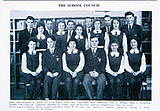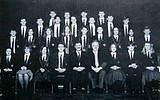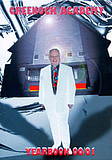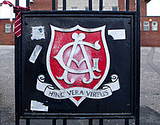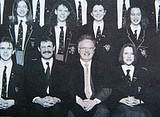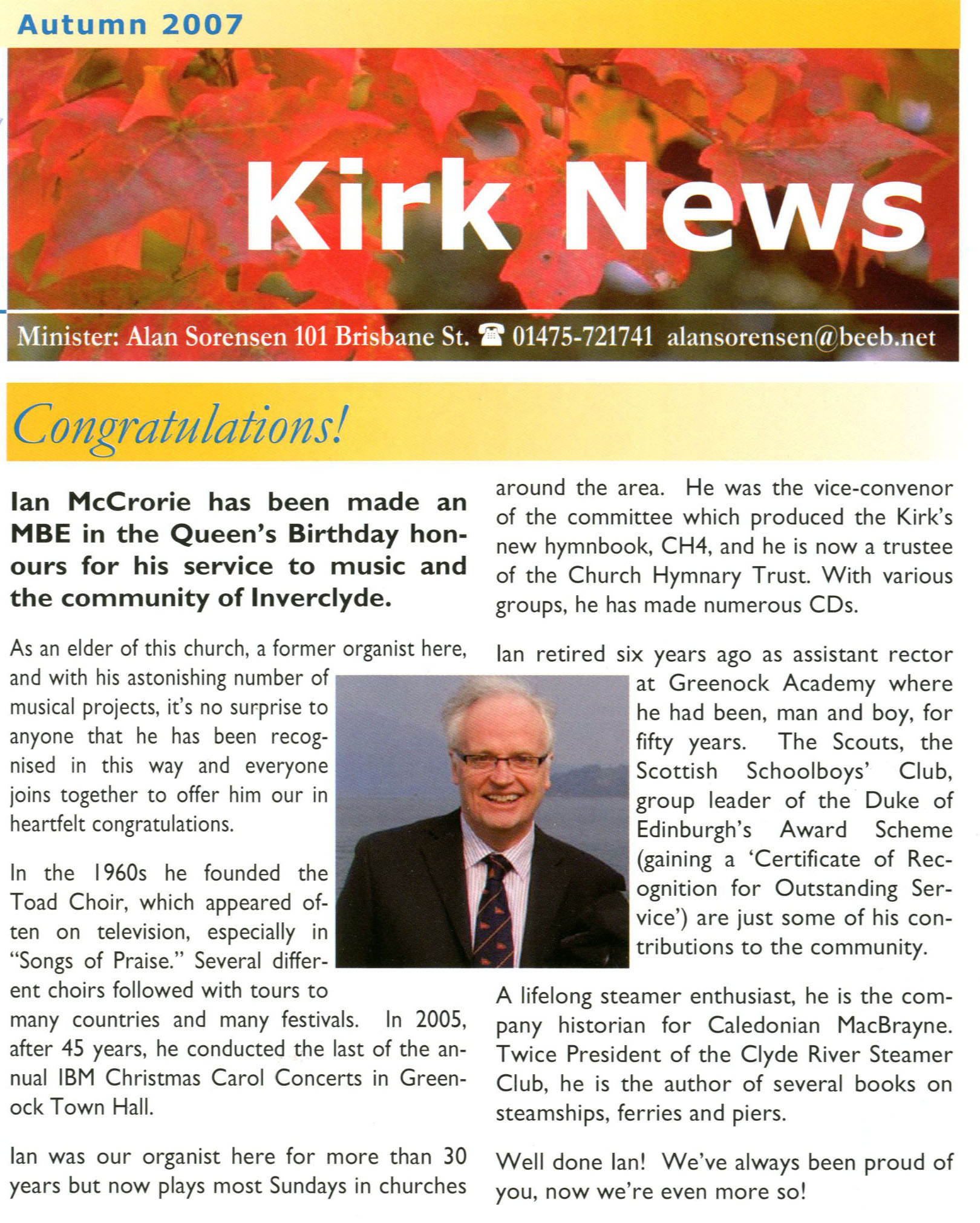Ian McCrorie is a well known and very popular figure in the Greenock area for several reasons, the main four being:-
-
His contribution to education as a Chemistry teacher and as Assistant Rector of Greenock Academy.
- His contribution to Music in the Inverclyde area and beyond.
- His love of and enthusiasm for steamers and the many books he has written about his lifelong hobby.
- His connection with the Church of Scotland.
Ian was born in Union Street,Greenock, on 6 May 1941, the night of the Greenock Blitz. He has lived all his life in Greenock where his contribution to the community is much to be admired.
Ian’s father taught Primary 7 at Greenock Academy until 1951. Ian was a pupil there from 1946 till 1959 (in the Nelson Street building) in both primary and secondary departments. He was Head Boy of the school in session 1958-59.
School Career
There were three paths which Ian’s career could have taken. He always wanted to become a teacher. He might have taught Classics as he took both Higher Latin and Greek. Alternatively, his love of music could have enabled him to make music his career; but it was his interest in science which led him to take a degree in Chemistry.
After Greenock Academy, Ian went to the University of Glasgow where he gained an Honours Degree in Chemistry. He then attended Jordanhill College of Education before returning to Greenock Academy as a Chemistry teacher. It was not his intention to go back to his old school but two Science teachers had just retired and he was offered one of the places. It was strange for him to be a staff member rather than a pupil and to wear a gown rather than a blazer. The school had just flitted from Nelson Street to Madeira Street and Ian joined the staff in the first full year in the new building. With the introduction of the Guidance system in 1979, Ian became Principal Teacher (Guidance, Social and Leisure) and was later promoted to the post of Assistant Rector at the school.
Ian believed very strongly in the importance of extra-curricular activities. In the early days he started the Scientific Society where lecturers from university or industry visited the school every fortnight or so. It was soon transformed into the Philosophical Society in order to work alongside the Greenock Society of that name. One highlight of this club’s activities was the summer term outing. Destinations became more and more exotic (for example, Iona in a day) with the inevitable result that the day trip became a weekend and the weekend a week – the Highland Tour was born. Originally there were forty or so in the party but by the time Ian retired a quarter of a century later there were a hundred. Every second year the tourers went to the Inner and Outer Hebridean Islands, some of the highlights being Fingal’s Cave on Staffa (where the party invariably sang!), the Cuillins of Skye and the Callanish Stones on Lewis. Every other year the destination was Orkney, and occasionally Shetland, the most memorable visits being to Skara Brae, Maeshowe, the Italian Chapel and the Highland Park distillery. On the last night, the party would stop in some catering establishment shut to the general public when, after a good heavy meal, the staff entertained the pupils, and vice versa, in song. Ian was not as involved as some staff in foreign trips, but he was party leader on one SS Uganda cruise to the Atlantic islands and was a staff member on a French exchange to Dijon.
As part of his PT’s duties, Ian looked after the school Tuck Shop, which made a lot of money for School Funds. The shop sold all sorts of confectionary, fizzy drinks and ice cream which would be considered unhealthy nowadays. As a corollary, he became School Treasurer, looking after an ever-increasing amount of money. One of his duties was to be staff liaison to the Sixth Year Charities Committee which gradually increased its contribution to school life and organised not only the annual Sponsored Walk but also events throughout the school session.
Greenock Academy was one of the first schools to embrace The Duke of Edinburgh’s Award, thanks to Classics teacher Donald A Williamson. More and more pupils became involved, with separate leadership for boys and girls. When Donald was promoted and left Greenock, Ian, who had been helping him, took charge of the boys’ activities. Usually a pupil achieved the Bronze Award in S3, the Silver Award in S4 and the Gold Award in S6. Each candidate had to be involved in some form of community service and a hobby (like music) but the activity which demanded the greatest amount of organisation and commitment was the expedition, especially at Gold level. In the 1990s, it was not uncommon for Greenock Academy to have more gold awardees than any other Scottish school. A highlight was the annual visit to Holyrood to receive the Gold Award from Prince Philip. On his retiral in June 2001, Ian received a signed certificate from the Duke as a token of thanks for his service.
Ian’s love of Greenock Academy is well known and he offered to update the Greenock Academy Centenary booklet in 2005 when the school reached its 150th birthday. This GA150 book is available to view at the Watt Library in Union Street.
As a matter of interest, Annabel Goldie, former Conservative MP and latterly leader of the Conservative MSP’s at Holyrood, was Head Girl at Greenock Academy when Ian taught there. He tells the story of the final week-end of Greenock Academy in 2012 when a speaker was unable to attend a function at the last minute and someone had to be found at very short notice” to fill in”. Former Head Girl, Annabel, stepped in and gave a superlatively good impromptu speech which was considered to be the best speech of the evening.
Music
Ian’s interest in music began when he was little more than a toddler. He was sent to a Miss Hodge for piano lessons at the age of four. The story goes that he was trying to play “God Save the King” on the piano but did not know the significance of the black notes. His father sent him round the corner to Miss Hodge, the well known piano teacher, who taught him to play and to read music. He has always been extremely grateful that this happened as he can read music as easily as the written word, having learned to do both when he was still an infant.
Ian began learning to play the church organ when he was in S5 at school. In 1961, the then minister of St. George’s Church in Greenock, Rev Bill Johnston, invited him to play the organ at his church. Ian agreed. That Christmas Mr Johnston introduced him to “Carols for Choirs” and invited him to assemble a choir to perform a Nine Lessons and Carols service based on it – quite a revolutionary idea for the Church of Scotland at the time. The book had been compiled by Reginald Jacques and David Willcocks of King’s College, Cambridge, and had just hit the music scene. The friends who had acted as the choir enjoyed themselves and were keen to repeat the experience. This indeed happened each Christmas. In fact Ian was approached by many of the singers to consider forming a choir of his own.
In October a meeting of friends was called to discuss the formation of an ensemble to compete in the Glasgow Festival. It didn’t have a name and this was a necessity for the entrance form for the Festival. Choosing a suitable name was a difficult decision when taking the average age of the choristers into consideration – Philharmonic or Choral Society didn’t feel right somehow. After several days of head scratching, a member of the choir produced, as a mascot, a toad in evening dress holding a conductor’s baton. Some say there could have been a comparison with the conductor’s girth. The group became the Toad Ensemble. Despite the desire among some members for change, the name stuck!
The group expanded to around seventy members and Ensemble changed to Choir. They performed with some success at the Greenock Festival in January 1965 and later that year sang in a BBC “Songs of Praise” broadcast which Ian had been invited to conduct – the second time he had conducted a “Songs of Praise”. He had already wielded the baton for a programme recorded at a boys’ club summer camp in the Perthshire hills. Such broadcasts continued to multiply – in 1967 he appeared on BBC Scotland. Another of the Toad Choir’s achievements was when in 1972 they competed in the prestigious National Choral Competition in the Royal Albert Hall in London and won!
Betty Terris, now a local Head Teacher, was a member of the Toad Choir. She remained a member when the choir became the Scottish Festival Singers and went to Poland to perform with this choir in 1984. Betty says she thoroughly enjoyed being a member of the choir and they had great fun together. She mentioned that Ian also did a lot of work with young people and took youngsters “Island Hopping” during the summer holidays. Her husband was also involved with the choir.
Margaret Glass, who works in the Central Library, is a former pupil of Greenock High School. She used to perform in the school shows and sang in the school choir. Margaret also joined “The Toad Choir”. “It was good fun and Ian McCrorie certainly knew his stuff,” said Margaret. “I learned a lot while I was in his choir. It was an enjoyable experience.”
The annual Christmas Carol Service was soon transformed into a full-blown concert with orchestra in GreenockTown Hall. It became immensely important to the local community which filled the hall to overflowing. IBM sponsored it for many years. Largely due to the popularity of the Christmas concert, Ian was able to persuade the Town Council to have an Allen Computer organ installed in the Town Hall. In 1974 the Toad Choir produced the ‘LP Record’, “Noel”, featuring favourite carols from the annual concerts. It was recorded in St Paul’s Church, Newark Street, and also showcased the Greenock Academy Primary Choir. This was, in fact, the second Toad record, the first having been produced the previous year; called “The Choice is Yours”, which comprised favourite hymns; the Toads starred on one side, with the London Emmanuel Choir on the other. One of the highlights of the Toad years was when the choir was invited by the Dowager Duchess of Hamilton to perform in front of HM Queen Elizabeth the Queen Mother at a special service to commemorate the coming together of the choir and the nave of St Mary’s, Haddington. The two parts of the great church had been separated since the Reformation.
It was in 1965 that the Edinburgh Festival Chorus was formed under the legendary chorus master Arthur Oldham. Ian and his wife Olive were so overwhelmed by a concert they gave that they felt a compulsion to join. They remained members for many years, despite having to juggle so many commitments, especially at Festival time in August. Ian considered Arthur his mentor and in fact he became his assistant, taking rehearsals when the maestro was elsewhere.
In 1975 Trevor Green, a good friend of the choir and a professional musician who had often been part of the orchestra or ensemble accompanying the Toads, was appointed to a managerial post within the newly formed Scottish Chamber Orchestra, which was part of the Scottish Philharmonic Society.. The Society wanted to be able to call on a choir of its own to sing with the SCO when appropriate. Ian was asked if he would be interested in taking on the job of moulding a group from the Toad Choir and by auditioning singers in the Edinburgh area, where the orchestra was based. This is indeed what happened. The Toad Choir ceased to exist as such and was subsumed into a new body – the Scottish Philharmonic Singers (SPS).
The choir performed with the SCO for some fifteen years. Ian prepared works for conductors such as Sir Charles Mackerras, Sir Simon Rattle, Sir John Pritchard James Conlon, Raymond Leppard and Witold Lutowlaski. The SPS were involved in the concert in Edinburgh’s Queen’s Hall when it was opened by Her Majesty in 1979. They continued to sing there frequently but also appeared in the Usher Hall and in various Edinburghcathedrals and churches. In addition, the choir and orchestra performed frequently in the City Hall in Glasgow but the Greenock Christmas Concert remained a firm annual favourite. The repertoire was wide – mainly baroque and classical works but also a sprinkling of modern pieces. SPS had their own identity away from the SCO; the choir often performed a cappella and featured in radio broadcasts and even on occasions with the BBC Scottish Symphony Orchestra.
The following years saw the Scottish Philharmonic Singers perform at the Aldeburgh Festival, Edinburgh Festival and Perth Festival. The SPS also travelled to Poitiers, Aix-en-Provence and Bordeaux and later Paris. A real highlight was the trip to Israel where they sang with the Israel Chamber Orchestra, but while there they joined Zubin Mehta and the Israel Philharmonic Orchestra at a special concert to mark the seventieth anniversary of the Habima National Theatre. In 1984 they were invited to give three concerts in Poland, a memorable tour on which they were accompanied by the BBC SSO. They also took part, with the SSO, in the BBC Proms in London.
SPS produced two records which have been made into CDs. In 1982, they recorded Rachmaninov’s “Vespers”, sometimes known as “The All Night Vigil”. Rachmaninov wrote the work during the Great War for the Russian Orthodox Church: the fifteen unaccompanied pieces are reckoned to be the pinnacle of such music. Returning to more familiar territory, the choir produced “Psalms of Scotland” in 1988. Comprising twenty of the best-loved metrical psalms and paraphrases, the original LP quickly became a best-seller. The organist on this occasion was John Langdon, who had accompanied the choir on many occasions, including in Greenock Town Hall.
The downside to all this activity was that SPS were not merely the choir of the Scottish Chamber Orchestra, as was the original intention, but were also leading an independent existence. The SCO management became acutely aware of this. Ian decided to retire with the result that a new choir called the SCO Chorus could be formed to perform solely with the SCO.
Having given what was to be a “farewell recital” in Durham Cathedral, Ian’s choir were then unexpectedly asked to perform the “Lockerbie Requiem” at the Edinburgh Festival – and in Lockerbie – as a tribute to those who had lost their lives in the terrorist atrocity. Again a name was urgently required and “Scottish Festival Singers” (SFS) seemed suitable. The members wished to continue singing and so the SFS started an independent existence. Prominent in the calendar was the Greenock Carol Concert, now accompanied by the BBC SSO. Other concerts followed with the SSO, the most notable being a performance of Benjamin Britten’s “War Requiem” under Martin Brabbyns in a shed in a shipyard in Govan to mark the fiftieth anniversary of VE Day in 1995. SFS still performed a cappella and on one occasion travelled to give recitals in churches in Venice. Several CDs of hymns were also recorded, first with John Langdon and then with John Kitchen as organist.
“Quit while you’re ahead” is always a good maxim. By 2005 the choristers – and choirmaster – were not getting any younger and Ian decided to call it a day. December 2005 saw the last Christmas concert in GreenockTown Hall, thus ending a run of 45 church services/concerts in the town.
Sir Malcolm Sargent had started the tradition of conducting an annual Christmas concert to raise funds for children who were suffering from cancer. His idea took off in a big way and concerts sprang up throughout the country. There was one held in Glasgow and for a few years Ian was the conductor. Pressure of time forced him to give up but now that he was rather less committed in other ways he accepted the invitation to return. The organisation was now known as CLIC Sargent, following an amalgamation with a charity with similar aims. Ian still conducts the annual CLIC Sargent concert in the Glasgow Royal Concert Hall. It is unashamedly based on the popular Greenock concert and many former attendees at Greenock Town Hall go along. In 2011 an incredible £41,000 was raised. This is now Ian’s major annual commitment in the field of music. Apart from playing the church organ he also leads various ad hoc events and still makes hymn CDs with SFS veterans and others. He also regularly appears at the National Mod as an adjudicator – of music rather than Gaelic!
The Church
Ian has been an active member of the Church of Scotland all his life. As a boy he attended Trinity Church, Union Street, which is now part of Lyle Kirk. He was appointed organist in the Mid Kirk – the Town Kirk – in the early sixties and remained there for thirty years. He was made a Church elder, as was his father before him. He regularly attends the General Assembly of The Church of Scotland, where he helps to precent the psalms and plays the organ in the Assembly Hall. He was a member of the committee which produced the Church Hymnary: Fourth Edition (CH4) and served on the church’s Panel on Worship for several years, latterly as convener of the music committee. He also conducted the choir in the promotional CDs for CH4. He is now a trustee of the Church Hymnary Trust and the Erskine Cunninghame Hill Trust and a member of the council of the Church Service Society. He still plays the organ virtually every week and is often to be seen at the console in Gourock’s St John’s and other churches in the area.
When he was a boy in Trinity Church, Ian joined the 59th Scout Troop which was associated with that particular congregation. One of his best memories is being one of the District’s representatives at the Jubilee Jamboree in Sutton Coldfield in 1957. The highest award in Scouting, the Queen’s Scout Award, had to be completed by one’s 18th birthday. Ian made the deadline by twenty minutes! He continued in the Scout Movement for some years, latterly as Scoutmaster of the 59th.
Another youth organisation which thrived in Greenock was the Scottish Schoolboys’ Club – loosely associated with the church. Ian joined when he was a pupil in Greenock Academy. One of the main features was the Sunday meeting where boys and officers met in a private house to discuss, in a fairly liberal fashion, the Christian faith – the forerunner of the house church? The main event of the year was the Easter Camp at Dalguise in Perthshire. Boys from many schools throughout the length and breadth of Scotland congregated for a week of fun, sports, competitions, sing songs and serious discussion. When he left school, Ian became an officer in the Club and eventually Chairman of the Greenock Branch. One year during his term of office a hundred boys from Greenock Academy attended Easter Camp. Summer camps were also held a little further north, at Bruar. For several years the Branch ran a very popular show called “All Weather Revels” in Greenock Arts Guild.
One of Ian’s former pupils, Fraser McNeill (class of 1995), became involved through the school with a charity called Project Trust and was sent in his gap year to Venda in South Africa. There he worked alongside a lady, Susie, who was using her home, a static caravan, as a nursery school for AIDS orphans. When Fraser returned to the UK he had an earnest conversation with Ian and suggested that if the churches of Greenock were to raise a few thousand pounds a proper school could be built. Ian was on Greenock Presbytery at the time and he chaired a committee which eventually raised the required amount. Together with Rev P Jill Clancy, minister of Gourock: St John’s, and Stuart Robertson, Session Clerk of the then Greenock: St Luke’s, he went out to Venda to the opening of the new school and in fact made a speech in the native dialect as well as joining (in his kilt) in an African dance. More fundraising has followed and the school, despite the difficult political situation, has gone from strength to strength. It has since been visited by two Moderators of the General Assembly. Fraser, incidentally, gained the top degree in his faculty at Glasgow University and is now a Senior Lecturer in Pretoria University. Another former pupil, Peter Nimmo, has also ‘fallen in love’ with South Africa and the connection thrives.
Steamers
Ian’s interest in steamers began when he was a boy. His great grandfather on his mother’s side had been the first stationmaster and piermaster at Wemyss Bay when the new station opened in the early years of the twentieth century. [Incidentally, he was the person who made the original hanging baskets in the station.] Because all the family lived in the area and worked on the railway or connecting steamers, it was natural that as a young lad Ian spent time sailing on the Firth; in fact when he was eight years old he and his friends took their first weekly Runabout ticket on the boats, at the princely sum of 10/-(50p) – with no accompanying adults. It was a safer world in those days. The ancestral home on his father’s side was the cottage next to Duart Castle in Mull and so the MacBrayne steamers in the West Highlands were also an important part of his life.
When Ian arrived at Glasgow University he became friends with another steamer enthusiast and the two of them joined the Clyde River Steamer Club which met monthly during the winter to enjoy lectures, share stories and show photographs. During each student summer Ian took a job as Assistant Purser on the Clydesteamers (earning a mere £2.50 per week), firstly on the ‘Holy Loch Maid’ and then on one of the car ferries sailing to Dunoon and Rothesay. Coincidentally, one of his uncles was piermaster at Dunoon. In his final year Ian graduated to the exalted post of Chief Purser on the small Countess of Breadalbane.
It was not long before Ian joined the Committee of the CRSC. At this time there were still several steamers sailing on the Clyde and the Club chartered some of the ships for special sailings. Ian became Convener of Cruises and organised trips all over the Firth. In connection with most of the sailings, he wrote a cruise brochure detailing the history of the route followed or the particular vessel chartered. Later he was elected Club President (twice, actually) and later still for a few years edited the Club’s Annual Review of Scottish shipping.
Another of Ian’s occupations was the writing of books on his hobby. A list is appended. The original two books were written with two friends and were revolutionary at the time as they embraced web offset printing technology. Many of the subsequent titles were requested by various bodies, especially CalMac. Possibly the most important is “Royal Road to the Isles”, a tribute to the 150 years of CalMac and its predecessors, written in 2001. CalMac appeared to like it and as a result the then chairman asked if he would consider becoming their Company Historian. As he was just retiring from school, Ian accepted and nowadays he answers queries, writes the occasional publication and gives historical lectures all over Scotland.
Ian has for many years been a member of the West Highland Steamer Club which, as the name implies, concentrates on the steamers and ferries – now CalMac – off the west coast of Scotland. He was a committee member for some years and is a Past President of this club too. He also has a close interest in the Waverley, the last sea-going paddle steamer in the world. When he retired, the staff of Greenock Academy presented Ian and his wife with a Life Commodore ticket for the Waverley – a hugely generous gift.
A list of the publications written by Ian McCrorie
Steamer of theClydeand Western Isles – 1964, 1965 [MacArthur, McCrorie & MacHaffie] [2 editions]
ClydeSteamers of Yesteryear – 1965 [MacArthur, McCrorie & MacHaffie]
Caledonian MacBrayne: Ships of the Fleet – 1977, 1980 [2 editions]
Clyde Piers: a Pictorial Record – 1982 [McCrorie, Monteith]
Hebridean and ClydeFerries (of Caledonian MacBrayne) – 1985
Clyde Pleasure Steamers: an Illustrated History – 1986
Steamers of the Highlands and Islands: an Illustrated History – 1987
To the Coast: One Hundred Years of the Caledonian Steam Packet Co – 1989
The Sea Routes to Arran– 1993
Dunoon Pier: a Celebration – 1997
The Three Ships “Hebrides” – 2001
Royal Road to the Isles — 2001
Tighnabruaich Pier – 2002
Lochranza Pier – 2003
Sea Routes from Mallaig – 2003
Pioneer – 2003
A Sea Road to Rothesay – 2005
CalMac Ferries – 2006
Kenilworth: the Story of the Kilcreggan Ferry – 2007
Caledonian MacBrayne: the Fleet – 2010
The Journey to Finlaggan: theSea Route to Islay– 2011
together with:
150 Years of Greenock Academy(GA150) — 2005
Personal
For the first seven years of his life, Ian was an only child. It was in 1948 that brother Peter was born. Peter married local girl and international opera star Linda Esther Gray: they have one daughter, Kirsty, married to Scott. Peter is now a Professor at London University.
It was at while at piano lessons with Miss Hodge that Ian met Olive. They even played duets together and sometimes competed in the Greenock Festival, singly and together. It was when they were in S4 and S5 in Greenock Academy that they became ‘an item’. After a long courtship they married in 1965 and lived first in Kelly Street and then since 1972 in Newton Street. Roderick was born in 1968, followed by Douglas in 1972. The boys, not unsurprisingly, shared their parents’ love of music (and to some extent steamers!). Rod is now a Professor at the University of St Andrews and Doug a Wine Development Specialist with a major UK supplier. Doug has one son, Finlay, the apple of Grannie and Grandpa’s eye! Olive was a huge support to her husband in the days of the Toads and SPS, accompanying the Greenock rehearsals and often the conductor’s rehearsals in Edinburgh.
Other Interests
Ian has never been particularly active in a sporting sense. In school his PE teacher suggested that rather than playing rugby, where he was very loyal but ineffective, he should lead the singing on the rugby bus! He and Olive are Social Members of the Royal Gourock Yacht Club and he not infrequently speaks or provides the music at sports club dinners. He is also actively involved in the Academicals Club, now embracing former pupils of Clydeview Academy as well as the old Greenock Academy.
As a fiftieth birthday present, his colleagues in school bought him membership of the Scotch Malt Whisky Society and he now canvasses among friends for folk to attend Whisky Tasting functions run by the SMWS in Greenock two or three times a year.
Robert Burns is another interest in Ian’s life. A member of the Greenock Burns Club (the Mother Club), he served for some years as musical director. He is also on the committee of the Gourock Burns Club and has been elected President for 2012-13 and 2013-14. The Cottars are a group of men who meet on the first Saturday of the year for a ‘Cottars’ Saturday Night’. Ian has provided the musical entertainment for some years and in 2012 was appointed Chief Cottar.
The Innerkip Society, Greenock’s oldest charitable society, has been close to Ian’s heart for some time. A former director, he rose to the rank of Preses in 2008. He is asked to provide the musical entertainment at the annual dinner in March. A prominent and promising young tenor or bass from the Sir Alexander Gibson opera school normally features, to great acclaim. One of Ian’s former pupils, Malcolm Offord, has appointed him a trustee of the Badenoch Trust, which disburses significant funds to the disadvantaged in society.
Ian was awarded the MBE for services to music and the community of Inverclyde in the Queen’s Birthday Honours in 2007. He was presented with the award by HRH the Prince of Wales at Buckingham Palace. He has been made a Paul Harris Fellow by the Rotary Club of Gourock and an Honorary Member by the Greenock Rotary Club. He also features as a “Hero of Inverclyde” on the wall of one of the pedestrian walkways in Greenock.
Sadly Ian passed away on 5th December 2019.
 Even though Ian has exceeded his “three score years and ten” Ian is as busy as ever in the local community.
Even though Ian has exceeded his “three score years and ten” Ian is as busy as ever in the local community.
The demise of Greenock Academy before “Waterloo Road” took over the building.
Ian McCrorie man and boy.

Ian McCrorie and “all that jazz”.



